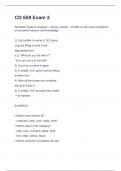CD 659 Exam 3
Semantic Feature Analysis - correct answer ✔builds on the interconnections
of semantic features and knowledge
1) If pt unable to name it, SLP gives
cues by filling a word in the
appropriate box
e.g. "What do you do with it?",
"You can use it to eat with"
2) Let pt try to name it again.
3) If unable, SLP gives cues by filling
another box
4) After all the boxes are complete,
ask pt to name it
5) If unable, SLP provides the model
-> pt repeats
EXAMPLE:
• Which word doesn't fit?
- cupboard, sofa, oven, table, shelf
• Which word is the category?
- sofa, oven, furniture, table, shelf
- red, white, yellow, black
• Which word fits? (complete the list)
,- Cupboard, sofa, ______
• Proving choices: oven, house, table, knife
• Ask pt to verbally respond
• What is it? (Name an object according to the clues)
- fruit, yellow, sour
• Same & Different
- TV vs. Radio
• Providing synonym or antonym
- Antonym: boy, cry, short, wet, buy, give...
- Synonym: beautiful, sick, smart, gift...
Compare "life participation approach" to "neuropsychological
approach/restorative approach." Being able to write a goal based on each of
these approaches. - correct answer ✔Restorative Approach
Stimulation Approach
- Identifying factor that impede pt's linguistic performance
- Focus on repetitive "sensory" stimulation in both auditory +
visual modalities
- Emphasizing clinician's feedback
- Using cueing/task hierarchies (hierarchical cueing)
- cueing gradually faded away
Cognitive neuropsychological approach
- Identifying the underlying process that is impaired
- Stimulating the impaired underlying process
- Recruiting more intact processes to help the impaired process
, à facilitating (using intact modality to assist impairments)
Life Participation Approach
-The explicit goal is enhancement of life participation
-Place life concerns of those affected by aphasia at the
center of all decision making
-Therapy turn to the external environment, trying to
modify it to adapt to the aphasia persons.
- NOT treating PWA but external factors including care
partners
What is Constraint-Induced Aphasia Therapy?
What is the rationale behind this therapy? - correct answer ✔is an intensive
therapy model based on the forced use of verbal oral language as the sole
channel of communication, while any alternative communication mode such
as writing, gesturing or pointing are prevented.
In aphasic patients, non-vocal communication channels (e.g. gesturing,
drawing or writing) have been considered compensatory mechanisms that
induce a form of verbal learned non-use, suggesting the potential value of the
transfer of the CIMT approach to support language recovery in stroke.13
Although the exact neurobiological principles underlying the positive effect of
CIMT are unknown, evidence from animal and human research have shown
that forced use of affected limbs/functions can promote cortical reorganization
though processes such as strengthening of the remaining neuronal
connections within damaged cell assemblies and unmasking silent neural
pathways
(Balardin, J. B., & Miotto, E. C.., 2009)




